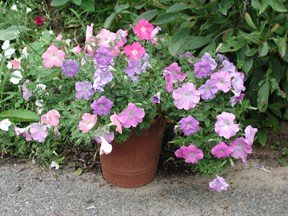
Petunias form blooms at the end of their stalks so continual clipping is necessary to keep them flower-filled all summer.
I was signing books at a local bookstore when a woman walked in with the ugliest hanging basket I’ve ever seen. Stringy, yard-long stems holding yellowing leaves cascaded over the rim of the pot. At the end of these leggy stalks were a few pitiful pink blossoms.
When petunias are in their prime, they are a mass of colorful flowers. But some gardeners end up frustrated that their plants become a tangle of long green stems with only some flowers at the end. Others find that their plants stop flowering mid-season, and the hanging basket that looked so colorful in May looks dreadful by August first. “Why do some people’s petunias look great all summer,” people question, “but mine become a mess by the end of July?”
Keeping petunias attractive all summer begins with knowing which variety you have so you can treat the plant appropriately. Next, some on-going maintenance is necessary in order to keep petunias blooming, especially if you’ve purchased a hanging basket that is already full and flowering in May. Finally, regular fertilization is important, particularly if the plants are growing in baskets or pots.
If you look at your petunia plants you will notice that they only form flowers at the END of the stems. So as the stems grow longer all the flowers are at the edges of the plants, with bare stems leading up to them. This is the case if you are growing the Wave, Super Petunias or regular ones.
In order to keep the plants full, bushy and not “stemmy” – you need to clip some of the stems each week. Ideally, this will start when you buy the plants and take them home, but unfortunately many people are hesitant to clip stems on a plant that looks good. Trust me, if the stems are already eight inches long or longer, you should start from week one. If you are starting with small plants that have stems less than eight inches, you can wait to start pruning.

Once an annual plant has produced a number of seeds it considers its job done, and stops flowering. So to keep regular petunias filled with colorful blossoms all summer, clip the stems just underneath the wilted flower right after the bloom fades.
Every week, clip three or four stems in half. The plant will produce two new growing tips (which will start to flower soon) just below each cut, so if you do this regularly from the start you will keep the flowers over the entire plant.
Be sure to water petunias that are planted in the ground deeply every four or five days remembering that a deep soaking less often is better than a little every day. Don’t hand water: you’ll get bored long before the soil has been deeply watered. Use a sprinkler or soaker hose. Fertilize every three weeks or use a combination of organic and time-release fertilizer when you plant. (The organic fertilizer becomes available to the plants just about the time when the time-release product has released all it’s nutrients.) If you are using a liquid fertilizer that isn’t organic, be sure to water the plants well before you fertilize, and let the plant become well hydrated before feeding: never fertilize a thirsty plant.
Deadheading only has to be done on regular petunias that form seeds. Varieties such as Wave and Super Petunias don’t make seeds so you don’t have to deadhead. Deadheading is CLIPPING THE STEM below the spent flower. I stress the stem because you can’t just pick off the wilted flower – you have to remove developing seeds that are BELOW the flower. If you use scissors to clip the stem below the wilted flower you will be clipping off the seeds, and the plant will flower more in pursuit of making more seeds.
What should you do if your plant is “stemmy” or has stopped flowering? Clip the stems back by 2/3 and fertilize. You could clip all at once, or do a third at a time (randomly over the plant – clip a third every week or 10 days) so that the plant isn’t cut back all at once. Either method will mean that the plant will take about three or four weeks to start blooming well again.
You can also root the ends of the stems you clip off – cut them to 8″ long and put them in fresh, damp potting soil after coating the stems with rooting hormone. Keep the pots out of direct sun but in a light place, and keep soil moist. Your cuttings should root in two or three weeks. After they start to grow, pinch the tip off to make it branch out, plant or pot it up and begin to fertilize regularly.
